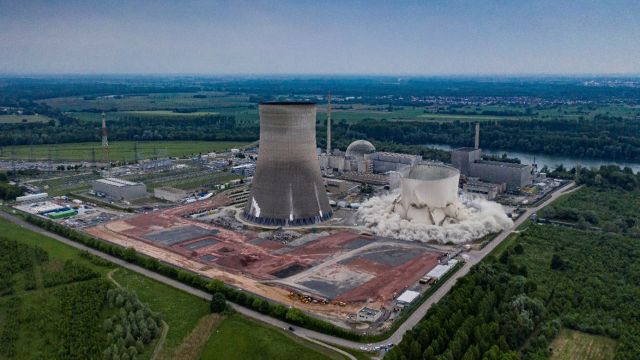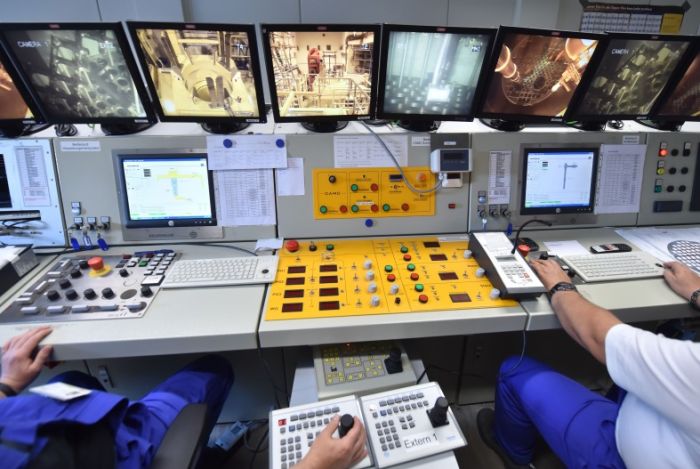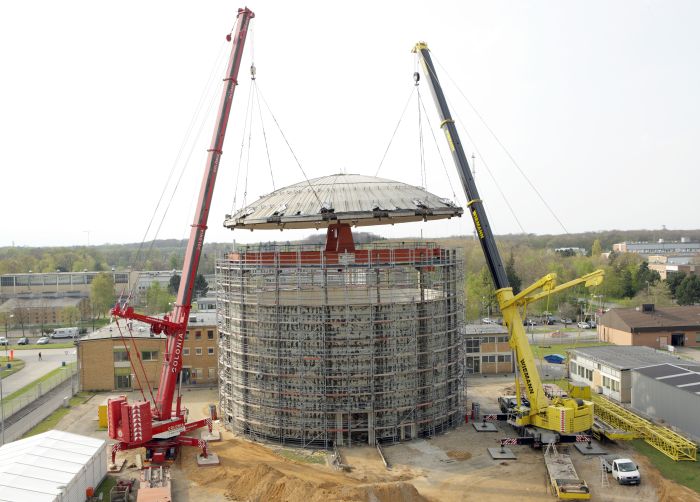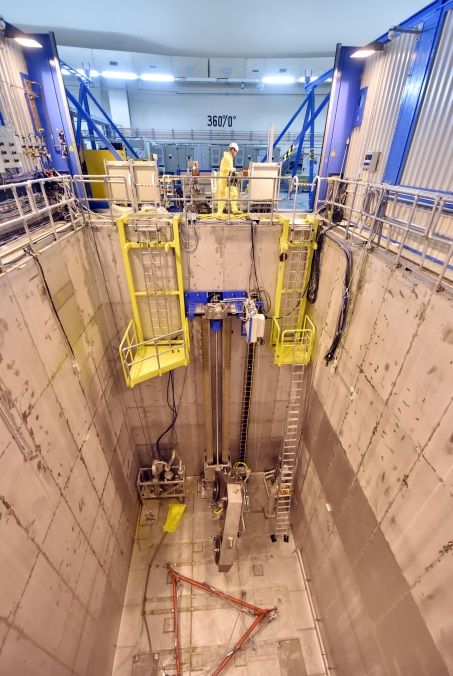
Decommissioning and dismantling: The last stage in the life of a nuclear power plant
The term "decommissioning" refers to the dismantling of a nuclear power plant and encompasses the entire process from post-operation through dismantling of the components, dismantling of all parts of the building to the natural initial state before the plant was built - the so-called "greenfield".
The Niederaichbach nuclear power plant, the Kahl experimental nuclear power plant and the superheated steam reactor in Großwelzheim are among the plants that have already been completely dismantled to greenfield sites. Their decommissioning has thus been completed. So far, 31 research reactors have been completely dismantled.
Post-operation: The phase after final shutdown
When a nuclear power plant is finally shut down and no longer feeds electricity into the power grid, the so-called post-operational phase begins. Although the reactor is no longer in power operation, the fundamental safety functions of subcriticality, heat removal and activity retention must still be ensured during the post-operational phase. Therefore, for example, the relevant systems for controlling accidents are still operational. The plant is still subject to the operating licence during this time.
The post-operational phase can last several years. It ends as soon as the operator has a licence for the decommissioning and dismantling of the nuclear power plant. During this phase, however, conventional plant components such as the generator can already be dismantled.

Dismantling can begin
Before a nuclear power plant can be decommissioned and dismantled, the operator must apply to the nuclear regulatory authority for approval. He must prove that he will safely dismantle the plant in compliance with all necessary regulations for the protection of people and the environment.
When the decommissioning licence is utilised, the actual dismantling of the plant begins. Measurements are taken in all areas of the plant and samples are taken to create a detailed overview of the radioactive inventory of the nuclear power plant.
There are different approaches to dismantling. In the past, those parts of the nuclear power plant that were not or hardly contaminated were dismantled first. Nowadays, the more contaminated or activated parts are dismantled at the beginning, partly by remote control, in order to reduce the activity inventory of the plant and thus the hazard potential as quickly as possible.
1. Decontamination
Contaminated objects and rooms must be decontaminated, i.e. freed from adhering radioactive particles, by special cleaning procedures such as sandblasting or ultrasonic cleaning. The removed radioactive material is collected and prepared for disposal.
2. Remote-controlled disassembly of activated components
Some plant components of the nuclear power plant - such as the reactor pressure vessel - have themselves been activated by neutron radiation during reactor operation, i.e. have become radioactive. For example, the stable cobalt-59 contained in the steel of the reactor pressure vessel is transformed into the radioactive cobalt-60 by neutron capture. This cannot be eliminated by decontamination. Since the dismantling of certain plant components would lead to high radiation exposure for the personnel, these components have to be disassembled into manageable parts by remote control.
3. Decay storage
Large, activated plant components, such as steam generators, are sometimes stored temporarily before dismantling to allow the radiation to decay. The plant components can then be dismantled with simpler aids and less radiation protection effort.
4. Demolition
Finally, the buildings will be demolished. Therefore, no changes will be visible on the outside of the NPPs for the first 10-15 years. The complete process of decommissioning a power reactor usually takes about 15 to 20 years.

An example: The Obrigheim nuclear power plant
The Obrigheim nuclear power plant, built in the 1960s in Baden-Württemberg on the River Neckar, was finally shut down in 2005. The first application for decommissioning and dismantling of the pressurised water reactor had already been submitted a year earlier. At the end of the summer of 2008, the authorities granted permission for this; the first dismantling work could begin. Plant components from the turbine building, such as turbines, generator, condenser, pumps, valves and water separator-reheaters, could be dismantled.
The application for the second phase of dismantling was submitted in 2008 and approved in 2011. It included the dismantling of plant components in the reactor building, including steam generators, reactor coolant pumps and reactor coolant lines.
The operator applied for the subsequent third dismantling phase in 2010. With the subsequent licence granted in 2013, the core of the plant - i.e. the core structure, the reactor pressure vessel and the so-called biological shield - could be dismantled. The reactor pressure vessel, which weighs about 135 tonnes, was transported to the dismantling area of the reactor building in August 2015. There, within a year, it was dismantled under water at a depth of eight metres, well shielded and remotely operated by band saw and plasma torch.
The application for the fourth and still ongoing phase of dismantling was submitted in 2015 and approved in 2018. In the course of this, the remaining systems and plant components, such as the ventilation systems, freight lifts, the crane system in the reactor building and parts of an equipment airlock, must be dismantled.
Dismantling is to be completed by 2025. The costs amount to around 600 million euros, which will be covered by the operator's reserves.

The challenge of occupational radiation protection: What are the precautions to protect personnel from radiation?
One challenge in decommissioning nuclear power plants is to protect the skilled workers involved from the possible effects of ionising radiation. Depending on the area in which the work arises, the workers wear protective equipment. Particularly strict radiation protection regulations apply to the controlled area of a nuclear power plant - regardless of whether it is in operation or shut down. Here, all workers must wear a dosimeter that measures radiation exposure. Authorities evaluate the dosimeters and check whether the legal limits are being observed.
The challenge of nuclear waste: What will happen to the waste accrued?
The dismantling of a power reactor produces about 750,000 tonnes of residual materials. The vast majority of this is not radioactively contaminated. Provided it comes from a controlled area, it can be recycled or disposed of conventionally after a control measurement and subsequent approval by the authorities. Only one to two per cent of the residual material is radioactively contaminated and must be stored in a repository for radioactive waste. Since no repository is yet available in Germany to accommodate such radioactive waste, the waste is stored in storage facilities close to the site.
Financial challenge: Who bears the costs of decommissioning?
The cost of dismantling a nuclear power plant varies depending on the type of plant, the strategy and the duration of dismantling. According to rough estimates, up to one billion euros are incurred per plant. The power utilities (EVU) pay for this amount. The responsibility for storage and disposal rests with the state. The utilities have paid around 24 billion euros into a public fund for this purpose.
Decommissioning abroad: Knowledge transfer as an international task
According to the International Atomic Energy Agency (IAEA), 450 reactors and 150 nuclear fuel supply and disposal facilities have already been decommissioned worldwide since the beginning of the peaceful use of nuclear energy. According to the International Energy Agency (IEA), around 200 nuclear power plants worldwide will have to be shut down and dismantled by 2040. However, not all countries have a wealth of knowledge and experience in decommissioning. For this reason, various international projects are working on making knowledge about decommissioning available to authorities, ministries and research organisations.
The international working groups help to answer open research questions and form a communication platform for the exchange of experiences for countries that will have to deal with the decommissioning of nuclear installations in the future and will then be faced with questions that other countries have already answered.
Is there still a need for research in the field of decommissioning?
The Federal Ministry of Education and Research (BMBF) has been funding research on nuclear decommissioning since the 1980s. Since 2017, around eight million euros have been budgeted annually for this purpose. Research and innovations are intended to make dismantling and the disposal of radioactive waste as safe, efficient and resource-conserving as possible and to support the training of highly qualified specialists. The decommissioning of nuclear installations is no longer new scientific territory per se, but there is nevertheless considerable potential for innovations to increase the efficiency of the processes and methods used and to minimise radioactive waste quantities, for example with a view to greater automation (e.g. through robotics) and digitalisation.
On behalf of the BMBF, the project management agency GRS implements the research programme for the decommissioning of nuclear installations (FORKA) and provides project support for "Decommissioning, dismantling and disposal of experimental nuclear installations". The project management agency GRS supports the Ministry in controlling as well as in the scientific-technical monitoring of the extensive decommissioning and waste management projects financed by the Ministry.
For example, a team of GRS researchers has developed a method within the framework of a FORKA project in cooperation with the University of Cologne that can be used to quickly and reliably characterise reactor graphite in order to determine a suitable waste management option.
In addition, the departmental research of the Federal Ministry for the Environment, Nature Conservation, Nuclear Safety and Consumer Protection (BMUV) deals with fundamental and current safety-related problems associated with the decommissioning of nuclear installations.
Researchers at GRS are currently investigating e.g. on behalf of the Federal Environment Ministry whether the methods used in decommissioning correspond to the current state of the art in science and technology and where there may still be potential for optimisation. Another example looks at what can be learned from the completed and far advanced decommissioning projects for future decommissioning tasks.